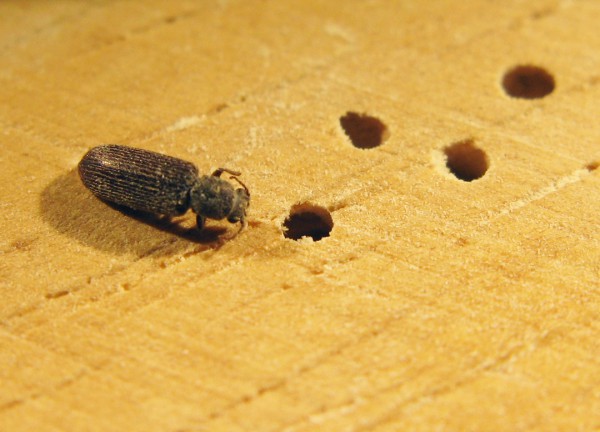POWDERPOST BEETLE
Lyctus brunneus
[Coleoptera: Bostrichidae]

Australian Powderpost Beetle (Lyctus brunneus):
Behavior, Impact, and Control
The Australian powderpost beetle, Lyctus brunneus, is a significant pest species known for its destructive impact on timber products.
Belonging to the family Bostrichidae, this beetle poses a considerable threat to timber structures, furniture, and other wooden materials. In this article, we delve into the intricate details of Lyctus brunneus, exploring its life cycle, distribution, pest status, and strategies for effective, low-toxicity pest control.
Reproduction & Life-cycle
The life cycle of Lyctus brunneus typically consists of four stages: egg, larva, pupa, and adult. Understanding each stage is crucial for implementing effective control measures.
Egg Stage: Female beetles lay their eggs in crevices and pores of unfinished wood, particularly hardwoods such as oak, ash, and hickory. These eggs are extremely small, barely visible to the naked eye.
Larval Stage: Upon hatching, the larvae bore into the wood, feeding on its cellulose content. This feeding activity is what causes the characteristic powder-like frass, hence the name “powderpost” beetle.
Larvae can remain within the timber for several years, depending on environmental conditions and timber quality.
Pupal Stage: After completing their larval development, the larvae pupate within the wood. Pupation typically occurs close to the wood surface.
Adult Stage: The adult beetles emerge from the wood through exit holes, which are typically small and circular. They are nocturnal and attracted to light. Once emerged, they seek mates to initiate the reproductive cycle anew.
Distribution
Lyctus brunneus is native to Australia, where it is widely distributed across various regions. However, due to globalization and international trade, it has been introduced to numerous other countries, including the United States, Canada, Europe, and Asia.
Its adaptability to different climates and its ability to infest a wide range of wood products make it a formidable pest in areas where it becomes established.
Pest Status
The presence of Lyctus brunneus in wooden structures can lead to severe economic losses due to the damage inflicted on timber products.
Infestations can weaken structural integrity, compromise aesthetics, and reduce the value of affected wood items. Furthermore, the fine powder produced by feeding larvae can contaminate surrounding areas, leading to hygiene concerns and respiratory issues for occupants.
Low Toxic Pest Control Strategies
Controlling Lyctus brunneus infestations requires a multifaceted approach that combines preventive measures, monitoring techniques, and targeted treatments. Here are some low-toxicity strategies for managing these pests:
Wood Selection: Opt for wood species less susceptible to Lyctus brunneus infestation. Hardwoods like teak, mahogany, and walnut are more resistant compared to softwoods like pine or spruce.
Surface Treatments: Applying surface treatments such as borates or permethrin-based products can deter adult beetles from laying eggs and inhibit larval development. These treatments penetrate the wood surface, providing long-lasting protection.
Heat Treatment: Subjecting infested wood to high temperatures can kill all life stages of Lyctus brunneus. Heat treatment is an environmentally friendly approach that eliminates the need for chemical pesticides.
Fumigation: Fumigation with phosphine gas is an effective method for treating severe infestations. However, it requires specialized equipment and trained professionals to ensure safety and efficacy.
Monitoring: Regularly inspecting wooden structures for signs of infestation, such as exit holes, frass, and beetle activity, allows for early detection and prompt intervention.
Proper Storage: Store wooden items in dry, well-ventilated areas to discourage Lyctus brunneus infestation. Avoid stacking wood directly on the ground and maintain low humidity levels to deter beetle activity.
Natural Predators: Encourage the presence of natural predators such as parasitic wasps, which prey on Lyctus brunneus larvae, helping to control populations in outdoor environments.
The powderpost beetle presents a significant challenge for the timber industry and homeowners alike. By understanding its biology, distribution, and behavior, effective management strategies can be implemented to mitigate its impact.
Employing low-toxicity control measures not only helps to preserve wooden structures but also reduces the environmental footprint associated with traditional pesticide use.
Through a combination of prevention, monitoring, and targeted treatments, Lyctus brunneus infestations can be effectively managed, safeguarding valuable wood products for generations to
Ring us today for a no hassles quote or to organize an appointment, 0417 251 911
